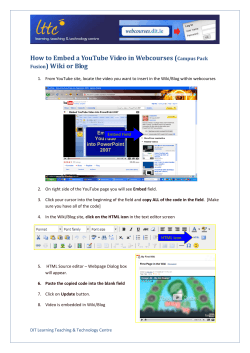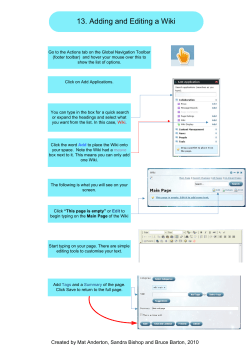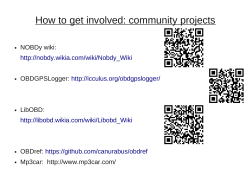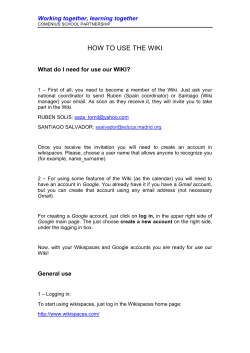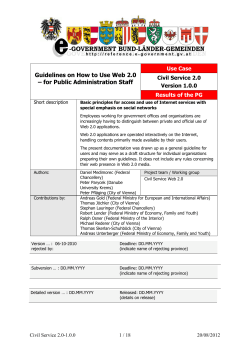
How to Reason by HeaRT in a Semantic Knowledge-Based Wiki
How to Reason by HeaRT in a Semantic
Knowledge-Based Wiki
Weronika T. Adrian, Szymon Bobek,
Grzegorz J. Nalepa, Krzysztof Kaczor, Krzysztof Kluza
AGH University of Science and Technology
al. A. Mickiewicza 30, 30-059 Krakow, Poland
{wta,sbobek,gjn,kk,kluza}@agh.edu.pl
Abstract. Semantic wikis constitute an increasingly popular class of
systems for collaborative knowledge engineering. We developed Loki, a
semantic wiki that uses a logic-based knowledge representation. It is compatible with semantic annotations mechanism as well as Semantic Web
languages. We integrated the system with a rule engine called HeaRT
that supports inference with production rules. Several modes for modularized rule bases, suitable for the distributed rule bases present in a
wiki, are considered. Embedding the rule engine enables strong reasoning
and allows to run production rules over semantic knowledge bases. In the
paper, we demonstrate the system concepts and functionality using an
illustrative example.
1
Introduction
The Semantic Web initiative promises new generation of the Web in which machines cooperates with people in solving complex searching, reasoning and planning tasks. Knowledge Representation (KR) methods developed for the Semantic Web stem from research in the field of Artificial Intelligence (AI), but they
concentrate more on useful and expressive data representation rather than its
intelligent processing. One of the most popular implementations of the Semantic Web concepts are semantic wikis. Over the last few years they have gained a
steadily increasing popularity in the fields of knowledge acquisition, management
and collaborative knowledge engineering.
Semantic wikis allow for enriching the content with semantic information.
The most widely used methods for knowledge representation in semantic wikis
are semantic annotations popularized by the Semantic MediaWiki (SMW) [2]
This is a draft version of a paper presented at the 23rd IEEE International Conference on Tools with Artificial Intelligence, ICTAI 2011, 7-9 Nov. 2011, Boca Raton,
c IEEE Xplore Digital Library:
Florida, USA. pp. 438-441 http://ieeexplore.ieee.org/xpls/abs_all.jsp?arnumber=6103361.
system and its extensions. They allow to assign categories and attributes to wiki
pages and define semantic relations among them; they facilitate navigation as
well as enable posing semantic queries. The semantically annotated knowledge
can be aggregated and queried, and simple classification tasks may be performed.
This is useful in encyclopedia-like systems, where users search for data by querying the knowledge included in semantic annotations.
In various practical applications, more flexible and dynamic KR methods
are desired. Enriching the representation with rules and providing an inference
engine enable reasoning beyond classification and querying. Based on the information stored in semantic annotations, new facts can be deduced, or desired
actions may be performed. Knowledge stored in the system may be considered
as a fact base for a rule-based system. In such a system, various inference modes
can be considered, including forward and backward chaining inference.
We have integrated a rule engine HeaRT [5] with a semantic wiki Loki [7]
into a hybrid system Loki-with-HeaRT. In this paper, we demonstrate how this
combination can be used to develop practical intelligent systems based on semantic annotations and rule-based reasoning. Loki-with-HeaRT combines the
semantic wiki flexibility in collaborative knowledge engineering with the power
of rule-based representation. Knowledge representation and processing in the
system is conceptually shown in Fig. 1. The system most important features can
be summarized as follows: 1) It uses a concise logical-based knowledge representation for semantic annotations and rules. 2) It provides reasoning capabilities
using powerful Prolog resolution algorithm. 3) By integrating the HeaRT engine,
it provides several reasoning modes operating on modularized rule bases. 4) It
facilitates knowledge acquisition by keeping compatibility with widely-used semantic annotations. 5) It supports knowledge sharing by exporting the content
to RDF and OWL.
We demonstrate the system functionality on a use case of a movie recommendation system. Its main goal is store information about movies and suggest
movies to users, based on the information they provide (such as age, favorite
genres, authors etc.) as well as the history of seen movies.
The rest of the paper is organized as follows: in Section 2 we present the
knowledge acquisition and querying with semantic annotations in Loki. Rule
format and reasoning with the HeaRT engine is outlined in Section 3. The underlying knowledge representation and processing of the combined system is then
explained in Section 4. The implementation of the system is briefly described in
Section 5. Summary and future work conclude the paper in Section 6.
2
Basic Semantic Annotations in Loki
The principle objective of Loki is to use a unified logical representation while
providing users with diverse knowledge acquisition methods. On one hand, Loki
supports semantic annotations as used in SMW, because they are commonly used
and intuitive even for untrained users. For example, the information that a movie
A has been directed by a person B can be expressed as: [[director::B]] within
querying:
SPARQL, Prolog
wikitext + annotations
SMW
Prolog
Rules
Ontologies
Loki Knowledge Base
Rule
Loki Engine
Engine
DL
Reasoner
Fig. 1. Knowledge representation and processing in Loki-with-HeaRT
the wiki page about A. Category assignment is done with the [[category:Name
of the category]] annotation, and an attribute value, e.g. a release date of a
movie, can be expressed with := operator (e.g. [[date:=2011]]). On the other
hand, users can define rules. More experienced users or knowledge engineers can
develop a complete rule base within the system (for details see Section 3). An
example of the wiki page representing a movie and recommendations based on
classification is shown in Fig. 2. The source wikitext for this page is as follows:
====== The Sunset Limited ======
[[category:movie| ]]
{{ :movie:the-sunset-limited.jpg?w200|}}
| **Release date**: [[date:=2011]] |
**Country**: [[country:=USA]] |
| **Language**: [[language:=english]] |
**Genre**: [[genre:=drama]] |
**Screenplay**:
[[screenplay::person:cormac_mc_carthy
|Cormac McCarthy]]
**Director**:
[[director::person:tommy_lee_jones
|Tommy Lee Jones]]
**Starring**:
Fig. 2. Semantic annotations in Loki
* [[starring::person:tommy_lee_jones
|Tommy Lee Jones]] - White
* [[starring::person:samuel_l_jackson
|Samuel L. Jackson]] - Black
====== Recommendation: ======
**Movies by this director**:
{{#ask: [[category:movie]]
[[director::person:tommy_lee_jones]]}}
**Movies in this genre**:
{{#ask: [[category:movie]] [[genre:=drama]]}}
Adding semantics based on a notion of categories, attributes and relations
is straightforward. This facilitates collaborative knowledge engineering, because
the wiki markup is flexible and easy to learn. In the presented use case, users
can add new movies, describe them with attributes and connect with relations,
extend the movie and people descriptions collaboratively developing the system
knowledge base.
Semantic annotations allow for querying the wiki with use of a simple ask
syntax as in SMW. Within a query one can use logical operators, wildcards, subqueries and property chains. Moreover, the sub-class and sub-properties relations
are analyzed and the simple reasoning based on classification is performed. The
output of the queries may be formatted as a list, a table, a CSV file etc. (see the
documentation1 ).
Loki supports Semantic Web standards for querying and exporting the system
data. SPARQL syntax is supported with an assumption that only the wiki system
may be queried, not any external source. The semantic content of the wiki may
be exported to an RDF/XML file (see the Export button in Fig. 2). Wiki pages
are exported as instances, relations as OWL Object Properties, attributes as
Datatype Properties. Subcategories are interpreted as OWL subclasses.
3
Reasoning with HeaRT
HeKatE RunTime (HeaRT) [5] is a lightweight embeddable rule inference engine
developed in the HeKatE project [10] 2 . It uses an expressive visual rule representation language called Extended Tabular Trees (XTT2) [8] which is based on
a network of connected decision tables. An exemplary network is given in Fig. 3.
The XTT2 representation allows HeaRT to support two inference modes: Data
Driven inference (DDI) and Goal Driven inference (GDI) which are forward and
backward chaining algorithms.
horrors
comedies
age
genre
filter
thrillers
science-ficton
Fig. 3. Schema of the XTT2 visual representation of the system
Visual representation of the rule base is human-readable but difficult to parse
and process. To this end, the HMR rule language is used 3 It is a simple and
readable text representation suitable for automated processing. The textual representation is automatically generated from the visual one, by a dedicated design
tools [10].
Let us now demonstrate rules used in the recommendation system outlined in
previous section. Rules written in HMR would be added and used to recommend
a movie set for a user of a given age and some film genre preferences. We use
1
2
3
See http://loki.ia.agh.edu.pl.
See http://hekate.ia.agh.edu.pl.
See http://ai.ia.agh.edu.pl/wiki/hekate:hmr.
separate wiki namespaces for each user of the system and another namespace
for movies. The schema of a visual representation of the rule base is presented
in Fig. 3.
Let us analyze the DDI run over this knowledge base. In the first step, the
system decides for which subsets of movies a user is allowed based on his age. For
instance, users younger than 18 are not allowed to watch horrors and thrillers
nor other movies that age limit is higher than 18. Then, based on the age filter,
the system search for movies that best fit user preferences specified in his profile.
In the end, the system responds with a list of recommended movies.
HMR language is embedded on wiki pages within <pl></pl> tags. An exemplary rule written in HMR is shown below. The rule should be read as follows:
If the age of the user is less then 18 and he marked horrors and thrillers as his
preferred genres, then set age filter to none.
xrule filter/1:
[age lt 18,
movie_types sim [horror, thriller]]
==> [age_filter set [none]].
To initialize attribute values (user age and preferences), the xstat element
from HMR language is used (see Fig. 4).
Fig. 4. Movie recommendations on a user profile page
In the presented case rules are located on separate pages. Such a modularization of knowledge base is especially useful when there may be several different
sets of rules that have common parts. It is easy to control system goals by controlling modules (namespaces) with rules. To merge all information, a scope has
to be given when a goal for the inference is specified. In the discussed system,
the construction scope="[user|movies]" is used.
It is also possible to browse through the database of movies and get information whether selected movie is recommended for the user or not. This is
a different reasoning task, because the inference works backward, not forward.
What is important, this functionality can be achieved without modifying the rule
base. Technically speaking, only one line of the wiki markup must be changed,
e.g.:
<pl scope="[user|movies]"
goal="gox(user,[comedy_rules],gdi),
print_results."> </pl>
4
Knowledge Representation and Processing
The knowledge acquisition layer described in previous sections covers the semantic annotations as used in Semantic MediaWiki (see Sect. 2) as well as rules and
state definitions in HMR language (see Sect. 3). All the knowledge, represented
in various ways, upon saving the wiki page is translated to the underlying logical
representation. This representation is based on a Prolog subset of First Order
Logic which allows to formulate and process Horn clauses.
Semantic annotations are translated into facts as follows:
[[category:movie]]
wiki_category(’movie’,’the_sunset_limited’).
[[director::person:tommy_lee_jones
wiki_relation(’the_sunset_limited’,
’director’,’tommy_lee_jones’).
[[date:=2011]]
wiki_attribute(’the_sunset_limited’,
’date’,’2011’).
Semantic queries are mapped into Prolog goals as:
{{#ask: [[category:movie]]
[[director::person:tommy_lee_jones]]}}
wiki_category(’movie’,Page),
wiki_relation(Page,’director’,
’tommy_lee_jones’).
To answer the semantic queries, the core Loki engine realizes the goals against
the knowledge base, using the Prolog resolution algorithm. For more advance
inference, the HeaRT engine is used. It can directly operate on facts stored in
the KB resulted from the semantic annotations.
One can also embed Prolog code (facts and rules) into the wiki, which may
be a convenient way of knowledge engineering for a group of qualified users.
Nevertheless, it is not necessary to know the Prolog syntax – using simple annotations and HMR rule language serves the goal of Loki to provide a flexible and
user-friendly environment.
5
System Design and Implementation
Loki has been designed as an extension to a popular wiki engine Dokuwiki 4 . The
Loki functionality has been added with used of Dokuwiki plugins mechanism.
The first prototype implementation called PlWiki (Prolog-based Wiki) has been
described in [4]. Knowledge engineering with this prototype has been discussed
in [6]. For details about the system architecture see [7].
Technical aspects of the integration of the core Loki engine with HeaRT has
been described in [9]. The architecture of Loki-with-HeaRT is divided into two
modules: the one responsible for rendering wiki pages and extracting the HMR
code, and the other – for performing inference based on the HMR model passed
to it by the Loki engine.
The process of rendering a wiki page in Loki with HeaRT is as follows: 1)
Wiki engine parses the wiki page and extracts semantic information (categories,
relations, attributes, HMR code) and reasoning queries or goals for HeaRT. 2)
If HMR code for HeaRT is present, then depending on a scope defined in the
goal, Loki merges the HMR code from wiki pages in a given scope and passes it
to HeaRT. 3) HeaRT performs the reasoning process and returns results to the
Loki engine. 4) Loki renders complete wiki page the answer to a given query or
goal.
6
Summary
Loki is a knowledge-based semantic wiki that combines flexible knowledge
representation with strong reasoning mechanisms. On one hand, it is compatible
with popular semantic annotations. On the other, it is integrated with a rule
engine able to operate in various modes over modularized rule bases. The unified underlying representation enables processing knowledge acquired in different
ways. The architecture of the system is modularized and expandable.
The current state of semantic wikis development can be traced on the semanticweb.org
portal 5 . Most of semantic wiki systems that introduce rules to their syntax,
do not take full advantage of this representation. For instance, rules available
in AceWiki [3] are translated to OWL, and during reasoning are processed as
First-Order calculus expressions loosing strength of rule representation. To the
best of our knowledge, no structuralization of knowledge base is provided by any
4
5
See http://dokuwiki.org.
See http://semanticweb.org/wiki/Semantic_wiki_projects.
of the semantic wiki systems. In KnowWE [1], there is a possibility of expressing knowledge with decision tress, but during translation from decision trees to
rules, the dependencies between them are lost, which slows down the inference
process.
For future work, we plan to implement an import facility, so that external
ontologies can be used in the system. Moreover, integration with HeaRT will
move from embedding the engine into communication over TCP/IP network.
Using this architecture, more information will be exchanged between Loki and
HeaRT, e.g. the logged in user’s identifier, the currently viewed wiki page, the
date and possibly more state-related information. This will allow for even more
flexible and dynamic operations based on knowledge in the system.
Acknowledgment
The paper is supported by the AGH UST Grants.
References
1. Baumeister, J., Reutelshoefer, J., Puppe, F.: Knowwe: A semantic wiki for knowledge engineering. Applied Intelligence pp. 1–22 (2011)
2. Krötzsch, M., Vrandecic, D., Völkel, M., Haller, H., Studer, R.: Semantic wikipedia.
Web Semantics 5, 251–261 (2007)
3. Kuhn, T.: AceWiki: A Natural and Expressive Semantic Wiki. In: Proceedings of
Semantic Web User Interaction at CHI 2008: Exploring HCI Challenges. CEUR
Workshop Proceedings (2008)
4. Nalepa, G.J.: PlWiki – a generic semantic wiki architecture. In: Nguyen, N.T.,
Kowalczyk, R., Chen, S.M. (eds.) Computational Collective Intelligence. Semantic
Web, Social Networks and Multiagent Systems, First International Conference,
ICCCI 2009, Wroclaw, Poland, October 5-7, 2009. Proceedings. Lecture Notes in
Computer Science, vol. 5796, pp. 345–356. Springer (2009)
5. Nalepa, G.J.: Architecture of the HeaRT hybrid rule engine. In: Rutkowski, L., [et
al.] (eds.) Artificial Intelligence and Soft Computing: 10th International Conference, ICAISC 2010: Zakopane, Poland, June 13–17, 2010, Pt. II. Lecture Notes in
Artificial Intelligence, vol. 6114, pp. 598–605. Springer (2010)
6. Nalepa, G.J.: Collective knowledge engineering with semantic wikis. Journal of
Universal Computer Science 16(7), 1006–1023 (2010)
7. Nalepa, G.J.: Loki – semantic wiki with logical knowledge representation. In:
Nguyen, N.T. (ed.) Transactions on Computational Collective Intelligence III, Lecture Notes in Computer Science, vol. 6560, pp. 96–114. Springer (2011)
8. Nalepa, G.J.: Semantic Knowledge Engineering. A Rule-Based Approach.
Wydawnictwa AGH, Kraków (2011)
9. Nalepa, G.J., Bobek, S.: Embedding the HeaRT rule engine into a semantic wiki.
In: Proceedings of The 3rd International Conference on Computational Collective
Intelligence - Technologies and Applications (2011), to be published.
10. Nalepa, G.J., Ligęza, A.: HeKatE methodology, hybrid engineering of intelligent
systems. International Journal of Applied Mathematics and Computer Science
20(1), 35–53 (2010)
© Copyright 2025


